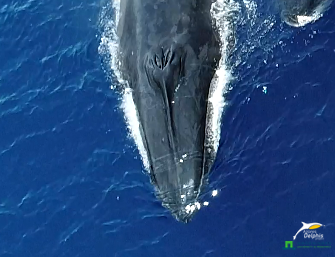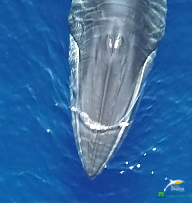2023 came to a strong start, with a grant from Catharine van Tussenbroek to fill the small gaps that we still had in our data. Although we officially started in June, the Azorean winter persisted until mid/end July but then surprised us with an ocean as flat as a lake.... for 2 weeks in a row! We filmed our study species, the common dolphins, but we also get to explore some new topics....
Common dolphins
Most importantly, we had ALL the trips with common dolphins! As we started late in the season, we had many glary days (where the sun hits the sea when it is not anymore at an angle but directly above us, which creates glare on the sea surface) despite waking up at 5am to prevent the glare. Despite that, the dolphins were collaborative and no super pods were found which is always a nice surprise!

MSc. Student

For our season we had a new Msc. student Bianca Vaz! She is doing her master's degree in the University of Exeter and she will look at the diving patterns of common dolphins using the drone data collected in 2022. Bianca was so excited about the Azores that she also got a job as a guide on board whale watching trips wit Picos de Aventura, our whale watching partner. She joined us all summer.
Hammerhead!
On our second trip we were out of the harbour quite early and look-out Filipe from Terra Azul did not arrive yet. As we scanned to see if we could find something ourselves, we saw a dorsal fin out of the surface and a moving tip at the back, the caudal fin. The two fin-tips out of the surface gave it away that it was a shark. But the species? We suspected a hammerhead because it was brownish. But to confirm this, we launched the drone and kept a distance with our boat, and indeed, it was a hammerhead!

After getting way too excited, we found out that the first drone failed to film, so with some panic (as these sharks usually dive almost instantly when spotted or approached by boats), we launched the second drone and yes, it was on time and stayed at the surface for the entire flight! We then checked what type of hammerhead it was. We came across this nice little sketch made by Johan Boshoff. The Great hammer head has a flat head, so we instantly excluded that. Then we had doubts between the scalloped and smooth hammerhead shark. But the notch in the middle of the head of the scalloped hammerhead was absent, so we confirmed that it was a smooth hammerhead shark (Sphryna zygaena).

Não Sei?
Não sei in Portuguese means "Not know" literally, or "I don't know". This was also applicable for the Sei whales (Balaenoptera borealis) that we were unsure of whether they were actually Sei whales. Last year we had a mixed species aggregation of a Brydes whale (Balaenoptera acoustrata) along with spotted dolphins (Stenella frontalis) and at first, we had identified it as a Sei whale. This year, once again we saw a baleen whale species that was foraging with spotted dolphins. It looked like a Sei whale from the surface (which is also the more commonly seen whale species this time of the year according to the MONICET data from opportunistic whale watching data that is collected). But we wondered if, just like last year, this was a Bryde's whale again. They are a slightly more warm watered/tropical species of baleen whale that are a more rare visitor in the Azores. However, with the drone we could once again confirm that this was a Bryde's whale.

See in the photo below, the way we can ensure that a whale is a Brydes whale and not a Sei is by the 3 ridges on the top of the head.
Left: Sei whale with one ridge (line on the middle of the head), Right: Brydes whale, 3 parallel ridges on the head.
Foraging aggregations with Tuna
The next species that we encountered was not a marine mammal mixed with a marine mammal. Every year (so far, since 2020) we've managed to film foraging aggregations with a lot of Tuna with dolphins. But nothing was comparable to what we filmed this year. What we saw was insane! First of all, more tuna than dolphins! Second of all, these tuna were huge and stayed at the surface for a very long time. We filmed them for an hour straight (switching drone batteries in between of course). The tuna was so clear that we could identify that it was a bluefin tuna (Thunnus thynnus). We, however, could not confirm that all of them were bluefin tunas as mixed aggregations are possible too.

Mantacatalog Azores
As a way to finalize our season we've visited Ana Filipa Sobral in Santa Maria, Azores. We have been collaborating since 2020. To explore further collaboration opportunities we spent a few days in Santa Maria testing our research methods with the drone on devil rays. Flying the drone, brainstorming and exploring wildlife from a bird’s eye perspective was done in the first few days. Taking advantage of the increased marine megafauna sightings from the last few weeks, we were lucky to encounter a hammerhead shark after filming a wreck called Canarias, a steamboat. We also took the chance to film Devil rays with a drone on board Haliotis Dive Santa Maria. Ironically there was also a pod of foraging bottlenose dolphins in the area. But for our main study species of this visit in Santa Maria, Azores, we focused on how well we could see the devil rays with a Drone. Check the video of our work here.
After that I joined Ana Filipa Sobral underwater to see how photo ID is done for Mantacatalog Azores at sea, and then the matching individuals to the catalog on land.

Post-processing of the drone footage is now in process, we can say that the methods used were successful, so expect to hear more about this collaboration soon!
That was all for our fieldwork season! We gathered the necessary data to fill the gap, so I will continue analysing the data and hope to have a next update on the results! Stay tuned!
The 2023 field-season is funded by Catharine van Tussenbroek, Research equipment and supervision is from Wageningen University, and researcher funded by: INREF: Beyond Anthropocene Pressures. The boat is used from the whale watching company Terra Azul Azores Whale Watch, a huge thank you for your support.
Author: Fadia Al Abbar



















